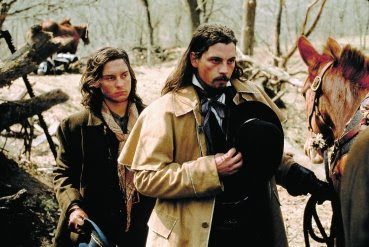
Ride With the Devil (1999) was dumped into the marketplace over a decade ago with only the most meager fanfare, a magisterial Civil War epic featuring several young rising stars that was somehow immediately rendered little more than a footnote of strictly cult interest in the careers of director Ang Lee and screenwriter James Schamus. All this despite the fact that this celebrated collaborative team had previously enjoyed enormous acclaim with Sense and Sensibility (95) and The Ice Storm (97), and would soon enjoy massive commercial success with Crouching Tiger, Hidden Dragon (00). After hearing it praised every couple of years or so by the few people I knew who’d managed to see it, I finally experienced Ride With the Devil for myself last week, thanks to a fine new release from the Criterion Collection. The film’s neglect now seems even more astonishing to me, given that it is surely the equal of Lee and Schamus’ finest work. It is a rare Hollywood film that embraces both a broad canvas and rigorously iconoclastic approach to one of the great troubled subjects of US history. Photographed by Frederick Elmes, it’s beautiful in its bucolic visions yet largely eschews gloss and doesn’t linger unduly on the prettiness of its stars. Based on the novel Woe to Live On, by Daniel Woodrell, it holds moments of tenderness of an endearingly awkward sort, yet most of its key scenes revolve around acts of rampant savagery that recall the most brutal evocations of Cormac McCarthy. It is, of course, a western of sorts.

It begins, shrewdly enough, with a wedding, the calm before the storm. It initially seemed to me burdened with too much overtly ominous and exposition-laden dialogue, but this passage is brief, and after we’re settled in our seats we’re quickly shaken out of them once the central characters’ lives are swept up in their nation’s apocalyptic crisis. We meet two friends, Missouri boys who unthinkingly side with the secessionists, Jake “Dutchy” Roedel (Tobey Maguire), the teenage son of a German immigrant, and Jack Bull Charles (Skeet Ulrich), who’s a little older and at times needs to look after the less experienced Jake. Their friendship is mirrored by that of the aristocratic George Clyde (Simon Baker) and former slave Daniel Holt (Jeffrey Wright), one of many black men who, for all kinds of reasons best not simplified, fought alongside those who were fighting to keep them enslaved. The story unfolds in such a way that it’s not obvious from the start who our real protagonists will be—Wright doesn’t even speak until 45 minutes in—a little narrative slight-of-hand that pays off brilliantly as we see the merciless vagaries of war wreak havoc on conventional heroic trajectories.

Residing far from the war’s hot points, these guys fight not as enlisted men but as guerillas, a point that serves to emphasize the chaos and meaningless violence that filled the margins of the Civil War’s official campaigns. The guerillas keep their hair long and wear broad-brimmed hats, looking like prototypes for Lynard Skynard. They fight only seasonally, hiding out over the winter, like animals, for fear that the tracks of their horses’ hooves will sabotage their strategies. They’re not organized like a regular army but are every bit as capable of atrocity, something made grotesquely clear in the films’ depeiction of the 1863 Lawrence Massacre, in which the guerillas, some of them already drunk, descend on the Kansas town at dawn, unannounced, to slaughter each and every man they find, sometimes while they lay wounded under the weeping figures of their wives. It’s the major turning point in Ride With the Devil, not in the sense that our central characters become suddenly politically enlightened, but that the infernal inhumanity they bear witness to finally reaches a breaking point. Most of the people being killed, Jake observes, “are just a bunch of ordinary folks finding out just how bad bad luck can be.”

Jake might just be Maguire’s most interesting role, one that invites him to trust in the verity of his inherent, saucer-eyed innocence, rather than trying to comment on the part or ingratiate himself. Though he’s naturally good-humoured, Jake’s learning curve is tremendous and deeply pathetic. It’s a marvelous moment when toward the film’s end he had his haircut and is told by his impromptu barber (Tom Wilkinson) that he looks 21 again. Jake says, “I’m only 19.” His barber tells him, “You’ll never look 19.” There’s an amazing scene soon after that finds the virginal Jake about to make love to a beautiful woman. She repeatedly asks him if he’s ever had sex, but all he can answer, rather defensively, is that he’s killed 15 men. But the most affecting and elegantly wrought piece of acting in Ride With the Devil is easily that of Wright, who never overplays the colossal irony of his role, but uses a little characteristic sway of the head or suspicious glance here and there to make his presence more than felt. Wright’s Holt is a character of vast complexity that needs to be at least partly left to our imagination, though there is a nicely measured scene that makes the core of his journey explicit, one in which he realizes that the most devastating moment in his adult life is also precisely the moment in which he begins to truly feel like a free man. It’s a quiet scene in a film of grand spectacle, yet it constitutes the film’s unforgettable emotional climax.
No comments:
Post a Comment